As climate change threatens coffee and tea production, where will our future buzz come from?
How caffeine went from natural to synthetic and why we should maybe expect more of it in the future.
This story is from The Pulse, a weekly health and science podcast.
Find it on Apple Podcasts, Spotify, or wherever you get your podcasts.
When a thousand Americans were surveyed in 2015 on their preferred brand of a breakfast staple — maple syrup — only about a quarter of respondents chose a product derived from actual maple trees as a favorite. The rest sided with the big-name brands that rely on corn syrup rather than real sap.
Pollsters didn’t have to search hard for an explanation: At the time, real maple syrup cost more than five times as much as imitators. A price trend that is likely to continue, as climate change bears down on real maple syrup production.
For most, maple syrup remains more of a condiment than a necessity – but what about the other breakfast item that almost all of us consider a necessity: caffeine?
According to the FDA, four out of five Americans consume the psychostimulant everyday. But as climate change threatens the production of tea and coffee, where will the source of that morning kick come from in the future?
“I think that for a lot of people, they’re surprised that we actually consume less coffee than our grandparents did.” said Murray Carpenter, author of “Caffeinated: How our daily habit helps, hurts, and hooks us.”
While researching his book, Carpenter discovered the switch from natural caffeine sources like coffee and tea to something different – something synthetic – happened long before the public was aware of the pressures of climate change.
“We consume a lot more coke and soft drinks, and more recently, energy drinks. So it’s been a big, a big shift,” Carpenter said. “And why that happened, I think you’d have to go to some really aggressive and terrific marketing for soft drinks.”
This shift happened back in 1975, when soft drinks officially supplanted coffee as America’s favorite overall beverage. While slick advertising campaigns didn’t hurt, Murray said it was really caffeine, not high levels of sugar or trace amounts of cocaine, that fueled the success of soft drink makers like Coca-Cola.
But that caffeine hadn’t always been synthetic.
“When Coke, for example, was really getting started, its primary source of caffeine was from Monsanto, which was then sort of a fledgling chemical company,” Carpenter said, “And they were extracting caffeine from waste tea leaves – so sort of substandard tea leaves, but of course, the caffeine would be just as good as any other tea leaves.”
Subscribe to The Pulse
After World War II, companies like Monsanto and Pfizer no longer wanted to rely on importing foreign caffeine crops for the fix Americans craved, so they started to synthesize caffeine from raw chemicals.
Today, most caffeine found in our sodas, energy drinks, and other processed products is synthetic – generally made from chemicals like urea and methyl chloride.
There’s little evidence consuming synthetic caffeine alone affects the human body any differently than natural caffeine alone. Still, as Carpenter discovered in an oral history account given by former Monsanto chemist William Knowles in 2008, Coca-cola allegedly worried about the optics of synthetic caffeine in its soda – or rather how it all sounded.
“Coke, which is the big customer, was afraid that somebody would get onto that we were making our caffeine in Coke from urea. Sounded too much like urine, you know what I mean?” Knowles said, according to the Science History Institute.
The company wanted to switch to a foreign supplier that promised it could provide natural caffeine instead. Knowles doubted this claim – so he said his team developed a test to determine whether caffeine was natural or synthetic: carbon dating.
Why this method?
Because the chemical ingredients used in the production of synthetic caffeine are derived from fossil fuels like natural gas. Thus, the carbon isotopes found in synthetic caffeine are much older than those in caffeine extracted from coffee beans or tea leaves.
“It would be interesting to determine what the greenhouse gas equivalent of a gram of caffeine produced from, say, synthetic versus, you know, coffee would be, but I think it would be a tough thing to do,” Carpenter said. “It’s not a calculation that I’ve done.”
Synthetic caffeine was produced in the United States for decades. Then one afternoon in 1995, a mysterious yellow cloud wafted over the Thames River, in Groton, Connecticut. It was a nitrogen oxide leak, a pollutant that can be harmful to those with asthma and weakened respiratory systems. It spewed from a caffeine manufacturing plant run by Pfizer. Workers were evacuated.
Carpenter said after the incident, synthetic caffeine production (and its pollution) mostly moved overseas, especially to China.
He wanted to see that production firsthand for his book, but was unsuccessful.
“It was in a word, frustrating,” Carpenter said. “I approached caffeine manufacturers in Germany, India, China.”
Every manufacturer either denied him access or didn’t respond to his inquiries, except for one facility in Shijiazhuang, China.
It was the world’s largest caffeine plant and its managers hadn’t yet outright rejected Carpenter’s request, so he traveled there to see if he could persuade them in person.
“It was in kind of a rundown industrial park. I mean, there were other places that made like veterinary medicines and, and Amido amino acids and vitamin supplements,” said Carpenter.
When he finally arrived at the plant’s gate, the area stunk like cat urine. The workers were friendly, but ultimately refused to let him in. And he’s not the only one who has historically struggled to gain entry into foreign manufacturers.
“Caffeine is like a lot of drugs. A lot of drugs or pharmaceutical components are now produced overseas. And so, caffeine is not alone in that way,” Carpenter said.
“Like many of the other pharmaceutical products, FDA inspectors don’t have necessarily an easy time getting access to these plants and doing their inspections. And just from the regulatory record, I know that there was at least one plant in China, where they did have like really filthy conditions.”
That synthetic caffeine plant was located in Jilin province. In August 2009, FDA inspector surveyed the plant and found rusty equipment, workers wearing open toe sandals and using dirty mops to clean the floor.
It took the FDA nine months to issue a warning letter to Jilin Shulan Pharmaceutical Company.
“Fifteen months after FDA inspectors went through there and found some really nasty conditions, Coke was still buying caffeine from that plant,” Carpenter said.
“So, that’s not to say that we’re consuming filthy caffeine, it is to say that the supply chain is, I don’t know, more opaque. It’s certainly a longer distance supply chain than most people would imagine when they’re drinking a soft drink.”
Carpenter noted that it would take a very large amount of impurities in synthetic caffeine to do harm to consumers.
Caleb Bryant, a market researcher from Mintel who monitors the U.S. beverage industry, said consumers don’t seem to care where their caffeine comes from.
“Overall awareness among consumers of whether caffeine is natural or synthetic is fairly low,” Bryant said. “However, there are brands that make that use of natural caffeine sources a prominent part of its overall branding, particularly in the energy drinks segment.”
While the energy drink sector has experienced huge growth, few companies emphasize using natural caffeine over synthetic. Bryant said using natural caffeine is still more of a marketing gimmick than a real concern.
Meanwhile, more and more young consumers are turning to coffee for their kick.
“It’s a growing industry particularly ready to drink coffees. So canned bottled beverage, coffee beverages. Growth stemming in large part from Millennial and Gen Z consumers. Gen Z in particular are huge fans,” Bryant said.
But as climate change and global conflict continue to create precarity for the coffee and tea industry, Bryant said beverage companies are trying to pivot.
“At the moment supply chain issues are kind of continuing to wreak havoc on the food and beverage industry. But, I think brands are taking a more long view of this where climate change is that existential threat to natural coffee production,” said Bryant.
“And, it’s really ultimately like, what does the future have in store for us? Are future consumers going to be able to enjoy universally loved products, such as coffee, wine, chocolate in the future? Or are they going to be more of [a] luxury good? Are there going to be more synthetic products on the market? Ultimately, it’s what is the impact of climate change on coffee production?”
The outlook is existential. And if those dire predictions come true, some companies will be waiting in the wings with alternatives, many of which will require help from synthetic caffeine.
But whatever tomorrow has in store, journalist Murray Carpenter is confident the future will be caffeinated, if not a bit less varied.
“We have been in probably a golden age of abundance and availability of some really top notch well produced tasty caffeinated products that I think that that production will definitely be challenged in the future.”
WHYY is your source for fact-based, in-depth journalism and information. As a nonprofit organization, we rely on financial support from readers like you. Please give today.







